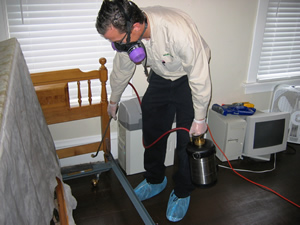Expert Bed Bug Exterminator Near Me: DC Exterminator Provider
Expert Bed Bug Exterminator Near Me: DC Exterminator Provider
Blog Article
Exploring the Scientific Research Behind Bed Bug Warmth Treatments as a Sustainable Insect Administration Approach
In the world of pest administration, the pursuit for sustainable and efficient options remains a consistent search. One such method that has obtained traction recently is using warmth treatments to fight bed insect problems. By harnessing the science behind thermal death points for these consistent parasites, heat treatments provide an appealing choice to typical chemical-based approaches. The complexities of exactly how warm properly removes bed pests and the more comprehensive effects for lasting parasite management practices make this a topic worth exploring further.
Bed Insect Warm Therapy Refine

Thermal Fatality Factor for Bed Insects
Subjecting bed insects to elevated temperatures past their thermal resistance variety is important for accomplishing efficient removal in heat treatment procedures. The thermal death point for bed pests describes the temperature level at which these pests can not endure. Research shows that bed bugs begin to perish when exposed to temperature levels over 113 ° F(45 ° C) for a sustained duration. As the temperature level enhances, so does the death price of bed bugs. At around 118 ° F(48 ° C ), bed pests begin to die swiftly, with a mortality price of almost 99% within minutes of direct exposure. This demonstrates the level of sensitivity of bed insects to high temperatures and highlights the effectiveness of warm treatments in eradicating problems. By reaching and preserving temperature levels above the thermal fatality factor for bed bugs, parasite administration experts can make sure detailed removal of bed insect populations, consisting of hard-to-reach locations where chemical therapies might be much less efficient. Comprehending the thermal fatality factor for bed pests is essential for carrying out successful warmth therapy strategies and accomplishing sustainable bug management outcomes.
Advantages of Warm Treatments
Having established the important thermal fatality factor for bed insects, it is essential to now explore the significant benefits that warmth therapies use in properly getting rid of these resistant parasites. When compared to traditional chemical approaches, warmth treatments present numerous vital advantages. One of the primary benefits is that warm can penetrate deep into crevices and splits where bed pests hide, ensuring that also one of the most hard-to-reach areas are heated to dangerous temperatures. This comprehensive strategy not next only kills real-time bugs yet likewise targets bed bug eggs, preventing future problems.
In addition, heat treatments are ecologically pleasant and non-toxic, making them a sustainable pest management method. Unlike chemical pesticides, heat treatments do not leave unsafe residues that can position dangers to human wellness or the environment. This aspect is especially crucial in delicate environments such as medical facilities, institutions, and suburbs where chemical use may not be desirable.
Additionally, warm therapies have a high success price in removing bed pest infestations in a single treatment, reducing the requirement for several sees and minimizing disruption to occupants. This effectiveness not just conserves time and cash yet additionally provides assurance to those handling bed bug problems.
Effectiveness of Warm Treatment

Study research studies have actually consistently demonstrated the performance of heat therapies in attaining a high rate of bed pest mortality. Correctly carried out warmth treatments can reach all the holes and fractures where bed pests may be harboring, making sure a comprehensive method to elimination. In addition, warmth treatments have the included advantage of eliminating bed bug eggs, which are typically immune to traditional chemical treatments. On the whole, the performance of warmth therapies in getting rid of bed pest infestations makes them a sustainable and reputable anchor bug administration technique.
Lasting Insect Management Conveniences
Applying sustainable bug monitoring practices uses long-term benefits for both the environment and public health. By utilizing approaches such as heat treatments for insect control, we can minimize the dependence on hazardous chemical pesticides that can have negative results on ecosystems and human health - bed bug heat treatment. Lasting pest management techniques assist in protecting biodiversity by targeting certain parasites without damaging non-target microorganisms, therefore keeping a well balanced ecosystem
Furthermore, sustainable pest management techniques add to the total wellness and health of the general public. By lessening exposure visite site to harmful chemicals used in traditional pest control approaches, warmth treatments offer a safer alternative for parasite management in residential, commercial, and public rooms. This reduction in chemical usage additionally assists in stopping pesticide deposits from polluting soil, water, and air, guarding ecological high quality.
Conclusion
To conclude, bed insect warm treatments have actually been shown to be a sustainable and reliable insect management approach. The thermal death factor for bed insects makes them vulnerable to heat therapies, which have various benefits over standard chemical therapies. The efficiency of heat therapies in getting rid of bed bug problems while reducing ecological impact highlights the possibility of this method as a lasting solution for bug control.
The bed bug warm therapy process involves elevating the temperature within infested locations to a level that effectively gets rid of bed pests and their eggs. By getting to and keeping temperatures over the thermal death factor for bed bugs, bug management experts can make certain detailed removal of bed insect populaces, including hard-to-reach areas where chemical therapies may be much less effective. One of the main advantages is that warmth can pass through deep into fractures and gaps where bed pests conceal, guaranteeing that even the most hard-to-reach areas are heated up to dangerous temperature levels. Unlike chemical therapies that might leave behind immune populaces, warmth therapies offer a environmentally friendly and non-toxic service that can permeate deep into furniture, walls, and other hard-to-reach areas where bed bugs conceal.
The thermal fatality factor for bed pests makes them at risk to warmth therapies, which have many benefits over standard chemical treatments.
Report this page